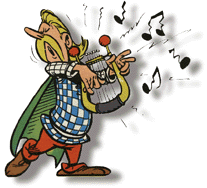 |
Musical Instruments of Antiquity as Illustrated in
|  |
Part 2: Roman Military Brass Instruments (Tuba/Trumpet, Cornu, and Buccina)
While I was working my way through college and graduate school, I served for 11 years as a military bandsman in the U.S. Army National Guard (Wisconsin, Minnesota, Illinois and Pennsylvania), so I can greatly appreciate the role that music and musicians play in the military.
Military musicians in the Roman army were senior centurions, the highest rank of noncommissioned officers, indicating the important role that musical instruments played in military communication. Trumpets, cornu and buccina were used to sound the alarm, to signal attack, retreat and formation changes during battle, to announce changes of the watch, and were played to provide accompaniment for soldiers while marching. The sculpture relief at right is a close-up of Trajan's Column and shows several Roman soldiers carrying and playing cornu. The Roman historian Vegetius, in his work De Re Militari, wrote:
The most important musical instrument in the Roman Military was the tuba or straight trumpet. The tuba/trumpet was usually made from copper or iron and was a conical bore straight tube about 120-140 cm in length and came in three pieces with a mouthpiece. The tuba/trumpet was used at sacrfices, processions, triumphal processions and funerals. However, it was primarily used to announce troop movements during battle, and it was intended to be played a loudly as possible. Julius Caesar is reported to have used trumpets to withdraw his troops from battle, and his Gaulish opponent Vercingetorix also used it. The second most important Roman military musical instrument was the cornu. This was an enormous instrument, curved into a large letter G with a crossbar for support. An original instrument unearthed in Pompeii was 320cm long, 140cm in diameter and had a detachable mouthpiece approximately 13.5 - 18.5cm long. In the military the cornu was primarily used to direct the movements of soldiers under a certain sign. In civilian life, the cornu was used to call the Roman people to assemble at important meetings, and later became associated with announcing the presence of the emperor. It was also played at the theater and gladiator fights. The buccina was similar to the cornu, except that it had a slightly smaller bore and a more flared bell opening at the end. The buccina was used to signal changes of watch during the night, wake up calls and for announcing mealtimes. Buccina players were not as high ranking as the soldiers who played tuba/trumpet or cornu - in addition to their musical responsibilities they also had to dig graves and cut wood. |
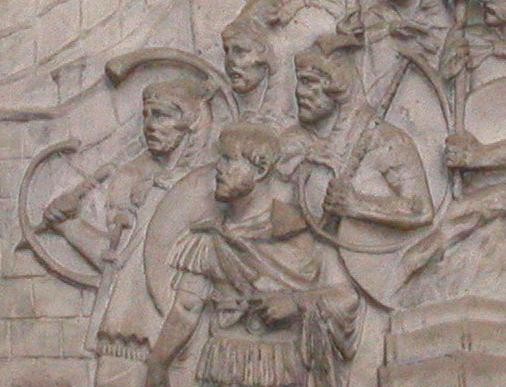
|
| As an example of the painstaking research and attention to detail that Goscinny and Uderzo poured into their work, a small panel from Asterix and the Olympic Games shows a buccinist sounding the call to mealtime for the soldiers in the Roman camp of Aquarium - one of the fortified camps surrounding the villiage of the Gauls. |
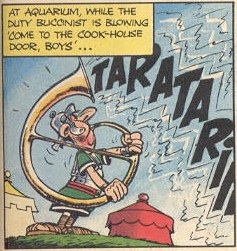
|
| In this panel from Asterix the Gladiator a Roman centurion is seen using animal horns, trumpets and buccina to prepare his troops for an attack. Unfortunately for the Romans, the Gauls - fortified with magic potion - quickly come crashing through the gate and pulverize the entire camp. |
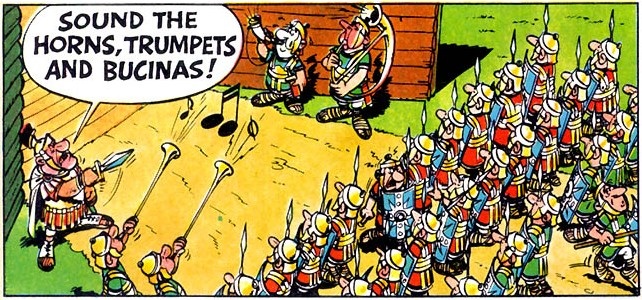
|
| Here, in a scene from Asterix and the Roman Agent, the trumpets and buccina are used to sound the alarm and ready the troops. A similar combined use of trumpets and buccina is shown at far right, from Asterix in Britain. |
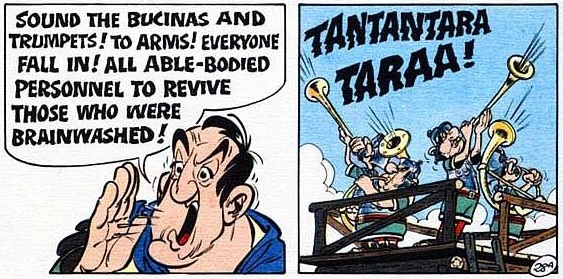 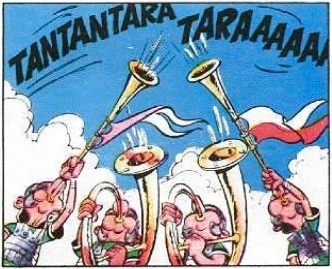
|
| Two later panels from Asterix and the Roman Agent illustrate the prominent placement of tuba/trumpets and cornu at the front of the army. As they prepare to march out to attack the Gaulish village the military musicians play march music. Unfortunately for the Romans, the ensuing battle ends as they always do - with the Romans battered and bruised and running a hasty retreat. |

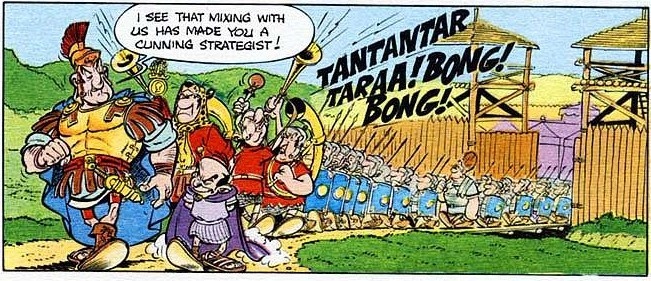
|
| In Asterix in Spain, a Roman military brass band performs at the Colosseum. Instruments include straight tuba/trumpets, curved cornu, and drums. Uderzo had a tendancy to draw cameo appearances of famous people in Asterix scenes. I'm guessing that the band director here is a famous band leader, but I can't place him. |
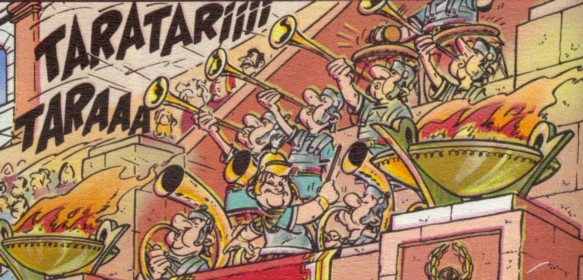
|
| This panel from Asterix and the Laurel Wreath shows cornu and tuba/tumpets leading a procession of captured barbarians - in this case the perpetually unlucky pirates - in a triumph procession. |

|
| In Asterix the Gladiator a cornu player leads a group of gladiators into the Colesseum. |

|
| In this sequence from Asterix the Gaul, Goscinny and Uderzo reveal the lesser known role of the tuba/trumpet player as game director in the Roman fortified camps. Here we see a group of Roman legionaires enjoying a nice game of musical chairs. It also appears that music was a bit heavier in ancient times than it is today. |

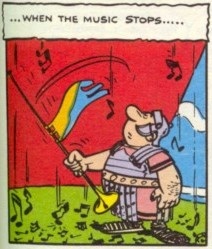
|
| Being a musician in the Roman army wasn't always a soft job, especially when you were commanded to play a "call to assembly" while struggling to keep from being sick as this poor fellow attempted to do in Asterix and the Sooth Sayer. |
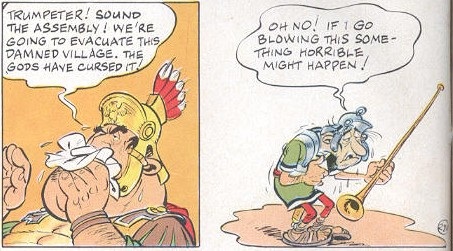
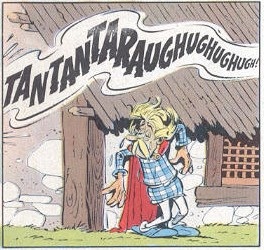
|
| The tuba, or straight trumpet, was not unique to the Roman military. This instrument was also emplyed by the Ancient Egyptians as is docmuented in this illustration from Asterix and Cleopatra. |
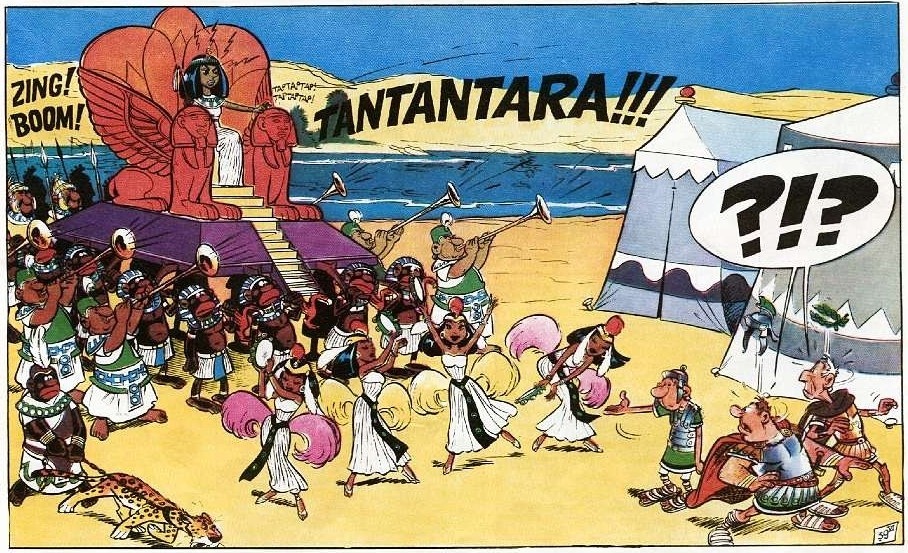
|
| Straight trumpet also used to announce the beginning of sporting events - in this case, a gladiator constest at a local county fair as shown in Asterix and the Cauldron. |
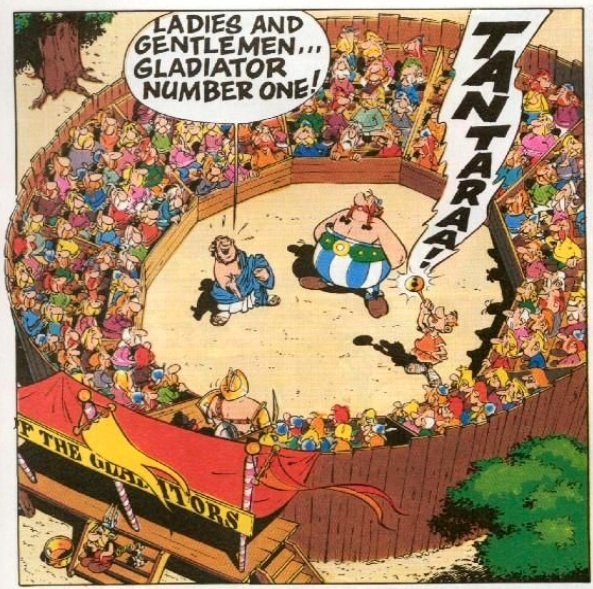
|
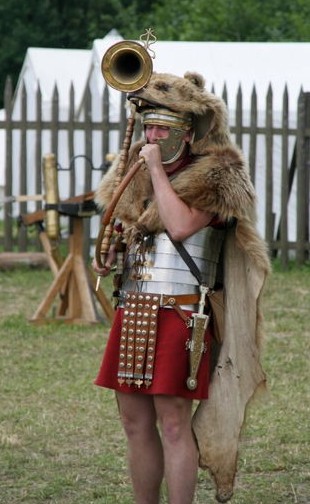
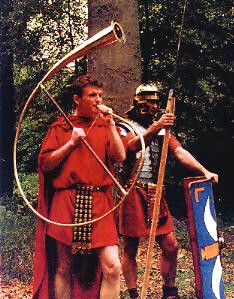
 Music in Asterix TOC
Music in Asterix TOC